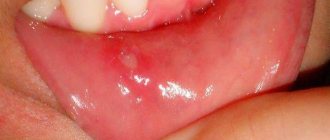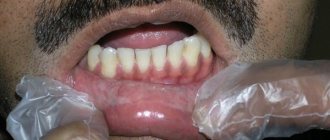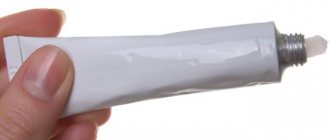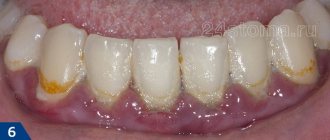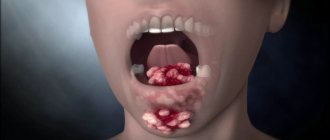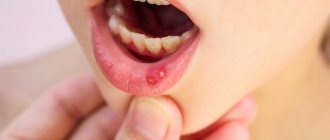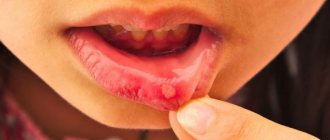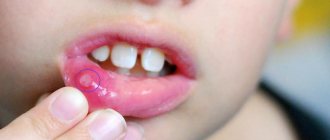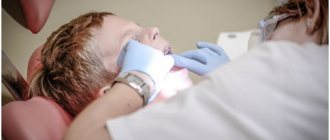What is stomatitis
Viral stomatitis in children is a pathological process characterized by damage to the oral mucosa by a viral infection. In children, the pathology progresses rapidly. This disease is acute or chronic.
The pathogen is transmitted in the following ways:
- airborne;
- through contact with the patient’s blood;
- contact-household.
The main source of infection is a sick person or animal. The baby becomes infected quite easily. Most often this happens in kindergartens and medical institutions.
3.Herpes
Herpes on the lips
appears due to a virus called herpes simplex virus type 1. Unlike ulcers, herpes is contagious from the moment the herpes blisters rupture until complete recovery. Primary infection often occurs during childhood and can be confused with cold or flu symptoms. Once a person becomes infected with the herpes virus, the virus remains in the body and lies dormant most of the time. But during stress, colds, injuries, hormonal changes, under the influence of sunlight, the virus is activated and herpes appears on the lips.
Herpes tends to appear in the same place. And in addition to infecting other people, the herpes virus can spread to other parts of the infected person's body - the eyes and genitals.
About our clinic Chistye Prudy metro station Medintercom page!
Causes
Viral stomatitis in childhood develops due to various infections, since the baby has an underdeveloped immune system. He does not have time to recover from his previous illness. It also easily becomes infected from a patient with stomatitis. The situation is worsened by a lack of nutrients and vitamins in the body.
The disease in children is caused by the following pathogens:
- flu;
- HIV;
- mononucleosis;
- measles;
- papillomavirus;
- ARVI;
- enterovirus;
- chicken pox;
- herpes.
Most often, herpes is the causative agent of this disease; it accounts for up to 80% of all cases. Most of these viruses are persistent intracellular parasites. Therefore, this disease often becomes chronic. With this form, there is an alternation of exacerbations and remissions. The acute form can result in the formation of a carrier state, in which the pathogen remains in the cells, but there are no symptoms of the disease.
Most often, the infection affects children under four years of age. But it affects older children and teenagers.
The reasons why this happens are:
- undeveloped immune system;
- insufficient oral hygiene;
- weakness of local immunity;
- injuries to the gums and oral mucosa;
- general weakening of the body after an illness;
- long-term use of certain drugs (glucocorticoids, antibiotics, cytostatics).
Parallel inflammatory processes in other organs and systems also contribute to maintaining the infectious process in the mouth of children.
How is it transmitted and is it contagious?
The main question that interests young mothers is how a baby can catch a disease and whether it is contagious in principle. Since stomatitis is an infectious disease, it is contagious, posing a threat to the family. The disease is transmitted in different ways:
- by airborne droplets;
- through shared utensils;
- when using personal items (towel, toothbrush, shared toys);
- through kisses.
In order to protect adults and children from infection, it is necessary that everyone has their own spoon, fork, and cup. The patient's dishes should be washed thoroughly and rinsed with boiling water.
Systematic oral hygiene helps minimize the risk of infection.
Symptoms
At the beginning of the disease, stomatitis is confused with ARVI and sore throat, as the child’s body temperature rises and a sore throat bothers him. Then the baby refuses to eat. A little later, drooling begins.
Symptoms of viral stomatitis in children fully manifest themselves by the third day of illness.
The following rashes appear in the oral cavity:
- erosions - these include areas of the mucosa devoid of surface epithelium, they are accompanied by severe burning and itching;
- bubbles - they are located on the inner surface of the cheeks, under the tongue, on the palate, a transparent secretion accumulates inside them;
- ulcers are defects in the mucous membrane, covered with a gray coating or films, sometimes they bleed, and the mucous membrane around them is swollen.
In the mouth you can see a white-gray coating and swelling of the tongue. The mucous membrane is red and swollen.
The baby's general symptoms are increasing. He is worried about general malaise. He is whiny, restless, eats and sleeps poorly. The baby has bad breath. An increase in the submandibular and cervical lymph nodes is detected.
Stages of stomatitis
According to the clinical picture, three types of stomatitis are distinguished.
Catarrhal stomatitis
The most common type of stomatitis, caused by poor oral hygiene, tartar and dental diseases. The mucous membranes become inflamed, red and swollen, but there are no ulcers or deep defects. Accompanied by bad breath, increased salivation, dryness and soreness of the mucous membranes.
For catarrhal stomatitis in the mouth in adults, treatment is first of all aimed at relieving inflammation, for which antiseptic solutions, rinses, lozenges, etc. are used. A gentle diet is required to avoid further injury to the mucous membranes.
After eliminating the symptoms of stomatitis, you can treat your teeth and carry out professional hygiene to get rid of tartar and prevent the occurrence of stomatitis in the future.
Ulcerative stomatitis
As a rule, this is the next stage of catarrhal stomatitis. The smell from the mouth intensifies, ulcers with a gray coating appear, eating is accompanied by pain. In some cases, the temperature rises and the lymph nodes become enlarged.
At this stage, only the doctor decides how to treat severe stomatitis and what combination of drugs is suitable in this case: they usually combine painkillers, antihistamines, vitamins, healing agents with antibiotics and treatment of rashes.
Aphthous stomatitis
At this stage, aphthae gradually form - round or oval erosive surfaces 3-5 mm in diameter with a red border and a gray-yellow coating. Aphthae can be single rashes or massively cover the inside of the cheeks and lips, the sides of the tongue, and the palate. Methods for treating stomatitis on the palate in adults depend on the severity of the stage and cause of the disease.
Diagnostics
If there is a suspicion of damage to the mucous membrane in the mouth, only a doctor, pediatrician or pediatric dentist should make a diagnosis and examine a child. It is important to identify the cause of the disease in order to prescribe effective treatment. Identifying the cause of the disease does not present any difficulties. This pathology is detected during examination due to the characteristic clinical picture, the presence of rashes, and signs of inflammation in the mouth. In addition to an examination to clarify the nature of the disease, the doctor prescribes a general blood and urine test. In severe cases, tissues of the affected mucous membrane are examined to identify the type of pathogen. For this purpose, washouts and scrapings from erosions and ulcers are taken.
The following methods are used to identify the type of virus:
- immunofluorescence method;
- PCR;
- RSK;
- ELISA.
In order to prescribe effective therapy, especially in severe cases, identification of the type of pathogen is required.
Advice from Dr. Komarovsky
Extremely popular among young mothers and fathers, Dr. Komarovsky draws attention to the fact that there are types of stomatitis - aphthous, herpetic, angular, enteroviral vesicular. All of them have a viral basis.
Many dentists generally consider the concepts of aphthous and herpetic stomatitis to be synonymous; their diagnosis and treatment methods are basically the same.
Angular stomatitis is popularly called “jams” - these are small cracks in the corners of the mouth. To treat them, an antibiotic-based ointment is often used, for example, triacutane.
The main thing that Dr. Komarovsky draws attention to is that if you suspect stomatitis, you must immediately consult a doctor so as not to waste precious time and begin adequate treatment as early as possible. With frequent relapses, there is reason to suspect the presence of another underlying disease, which requires a careful and comprehensive examination of the baby.
Treatment
Treatment of viral stomatitis in children is carried out under the mandatory supervision of a doctor. Mild forms can be treated at home; in severe cases, the baby is admitted to a hospital. Children are prescribed bed rest and a diet. Food should be pureed, warm, and not irritate the affected mucous membrane. The patient is advised to drink more fluids.
The disease requires complex therapy. For this disease, local and general treatment methods are used.
The following medications are indicated for the child:
- antiviral drugs (Panavir, Acyclovir) - taken strictly according to the regimen prescribed by the doctor; if you do not follow his instructions, a relapse of the disease is possible;
- antihistamines (Suprastin, Citrine, Loratadine) - reduce swelling and reduce pain;
- immunomodulators (Imunofan, Timalin) – strengthen the baby’s immune system;
- antipyretics (Panadol, Nurofen) are used at high temperatures.
Local remedies are used to treat infectious stomatitis. They relieve inflammation and swelling.
For this purpose the following are used:
- antiseptic solutions (Panavir, Miramistin) - the oral cavity is rinsed every hour with a soda solution or Furacilin, and then treated with antiseptics;
- dental gels (Kamistad, Dentinox), which have an anti-inflammatory, analgesic, disinfecting effect, are used thirty minutes before meals;
- antiviral ointments (Acyclovir, Oxolinic) - penetrate the virus and destroy it, the oral cavity is lubricated up to five times a day for two weeks.
Mouth rinses with herbal infusions are used. Herbs are used to relieve irritation and pain (chamomile, calendula, sage).
Physiotherapeutic methods are used: tube quartz, devices with infrared irradiation.
2. Causes of stomatitis
We have already talked above about why irritation of the oral mucosa may begin. Now let's dwell on the question of why ulcers and herpes appear. Ulcers.
In fact, the exact causes of stomatitis in the form of ulcers are not known. But many things can contribute to their development. These include certain medications, oral injuries, poor diet, stress, bacteria and viruses, sudden weight loss and the consumption of certain foods - potatoes, citrus fruits, coffee, chocolate, cheese and nuts.
Stomatitis may be associated with a weakened immune system due to colds, flu, changes in the body's hormonal levels, as well as a lack of vitamin B12 and folic acid. Even accidentally biting the inside of your cheek or chewing on a sharp piece of food can cause an oral ulcer.
Ulcers can occur as a result of a genetic predisposition. In this case, it is considered an autoimmune disease. In general, ulcers appear in about 20% of people, but the disease is not contagious.
Visit our Therapy page
Prevention
It is not possible to completely prevent the development of this infection in a child. Most people are already infected with viruses at birth, but it is quite possible to reduce the incidence of the disease.
To do this, the following measures are used:
- if one of the adults is infected, they should not be allowed to contact the child;
- choose a group in kindergarten with a small number of children;
- If possible, do not attend mass events during epidemics;
- it is necessary to harden the child (walk barefoot at home, go to the pool);
- stop bad habits (sucking fingers, toys, other objects);
- thoroughly wash and treat the child’s toys and dishes;
- treatment of all surfaces in the apartment using antiseptics.
Infectious stomatitis in children is a rather unpleasant disease. If you follow all the doctor’s recommendations and preventive measures, you can minimize the occurrence of this disease in your baby.
Preventive measures
A very important part of prevention is timely treatment of dental and ENT diseases.
Stomatitis can occur in anyone, regardless of age and lifestyle, but compliance with the following preventive measures can reduce this risk:
- Maintaining oral hygiene and timely treatment of dental diseases.
- Providing a balanced diet to supply the body with the necessary amount of vitamins and nutrients.
- Taking vitamin complexes in spring and autumn.
- Timely treatment of diseases of the ENT organs and digestive system.
- Rejection of bad habits.
Medicinal methods of treating stomatitis
Treatment involves an integrated approach and depends on the type of stomatitis. Includes general treatment (taking tablets orally, injections) and local therapy (rinsing, ozonation of lesions, laser therapy, applications with painkillers). In different cases, the following drugs are prescribed (together or separately):
- anti-inflammatory (Nimesulide, Miramistin, Cholisal);
- antiviral (Acyclovir, Zovirax);
- antiseptic (Eludril solution, chamomile, Furacilin);
- antihistamines (Suprastin, Fenistil);
- painkillers (Hexoral, Lidocaine);
- keratoplasty (olive and sea buckthorn oils, vitamins).
Note! Medicines should be prescribed only by a doctor, after examination and testing. Self-medication is unacceptable! To increase the effectiveness of drug treatment, it is recommended to adhere to a certain diet, excluding spicy, sour and salty foods from the diet. It is advisable to refrain from consuming too hot food and drinks, as well as crackers, cookies and the like (they can cause additional injury).
Types of stomatitis
There are several types of the disease. They differ in symptoms and treatment.
- Viral or herpes . Caused by the herpes simplex virus. Most often occurs in children from one to 4 years of age. Infection can occur through airborne droplets, when using shared utensils, toys, etc. After entering the human body, the virus remains there for life, manifesting itself during periods of decreased immunity.
- Aphthous . Scientists disagree about the causes of this type of disease, but there are studies confirming the presence of a genetic predisposition (often appears in families). Scientists also talk about the reaction of local immunity (to pathogenic microorganisms, allergens, local damage). The main manifestation is painful aphthae (round formations that turn into ulcers or erosions).
- Traumatic . It is - obviously from the name - a consequence of trauma. The injury can be mechanical (resulting from a blow, a fall, biting the inner surfaces of the lips, cheeks with teeth, scratching with sharp parts of a chipped tooth, dentures or braces), chemical (in children the most common cause is an attempt to try something inedible, in adults - smoking, alcohol), thermal (burn from eating too hot food or drinks).
- Enterovirus vesicular (EVS) . Otherwise called hand-foot-mouth infection. It is caused by enteroviruses, which are transmitted by airborne droplets and contact. You can also become infected from an asymptomatic carrier, including through touching objects (enteroviruses can live for quite a long time outside the human body).
- Bacterial . The most common cause is streptococci and staphylococci. It appears when local immunity decreases, which usually occurs when other diseases appear (problems with the gastrointestinal tract, endocrine system, advanced caries, etc.).
- Candidiasis . Or oral candidiasis (in common parlance - thrush). The causative agent is yeast-like fungi of the genus Candida (Candida). Just like many bacteria, Candida fungi are found in the body of an absolutely healthy person and begin to cause inconvenience when immunity decreases, vitamin deficiency, metabolic disorders (including diabetes mellitus), and during exacerbation of chronic diseases.
- Ulcerative-necrotic. The cause of its occurrence is spindle-shaped bacteria, fusobacteria, and spirochetes. Normally, all these bacteria live in the oral cavity, but they acquire pathogenic properties against the background of systemic diseases, poor nutrition, stress and other unfavorable factors.
- Allergic . Most often it is the body's reaction to pollen, fungal spores or food allergens. It can develop due to the use of low-quality materials for the manufacture of fillings, crowns, dentures, braces, as well as after undergoing a course of treatment with sulfonamides or antibacterial drugs.
Prevention of stomatitis
One of the main recommendations is maintaining oral hygiene. The risk of stomatitis will be significantly reduced by maintaining a healthy lifestyle, which implies, at a minimum, quitting smoking, alcohol, and maintaining a balanced diet. Particular attention should be paid to strengthening the immune system, because many bacteria turn into a pathogenic form precisely when the body’s protective functions are weakened. It is recommended to eat a large amount of vegetables and fruits, natural unrefined oils, avoid spicy, fatty foods, and do not abuse sweets and caffeine.
